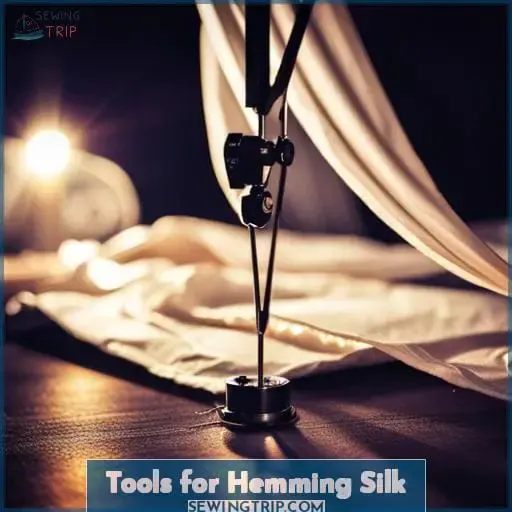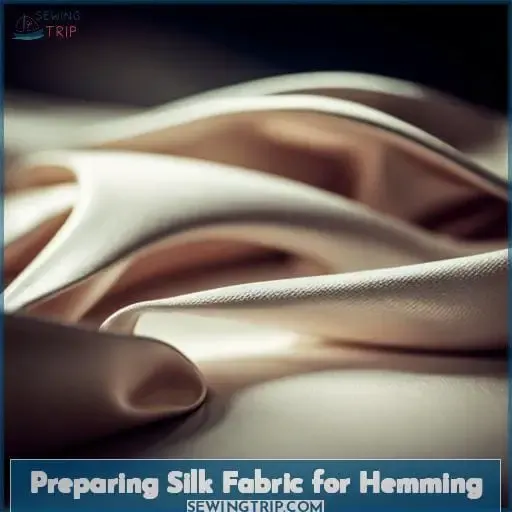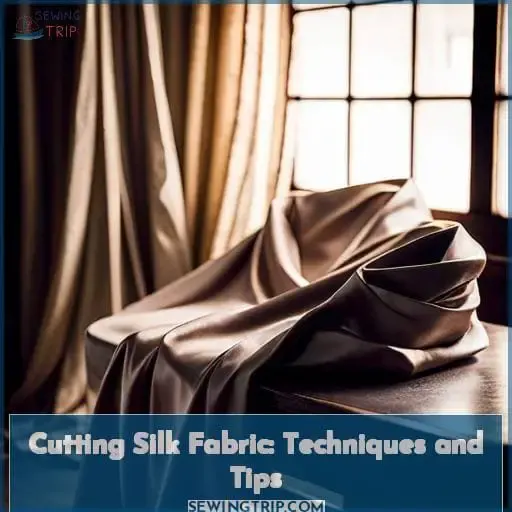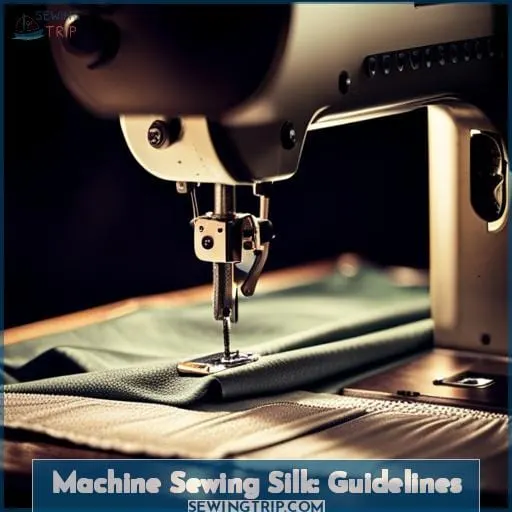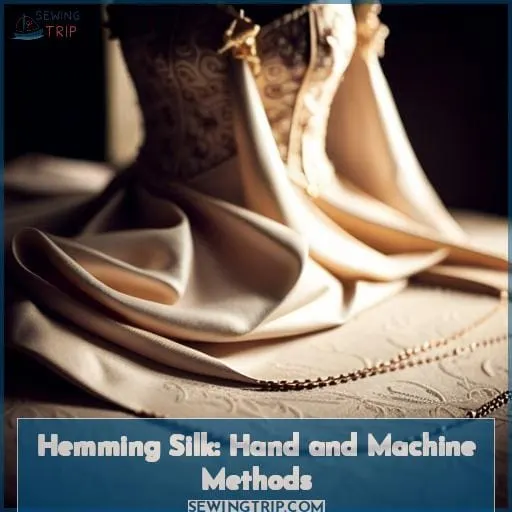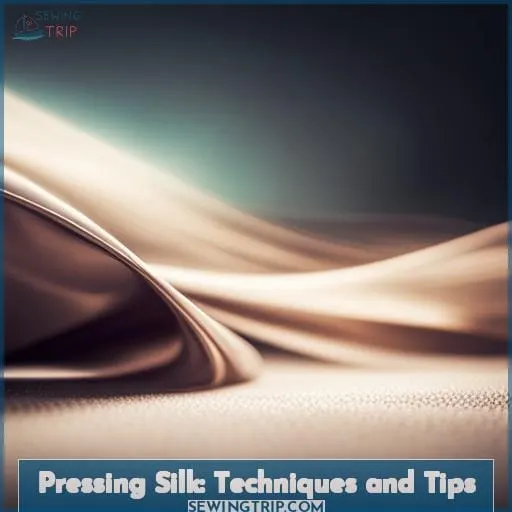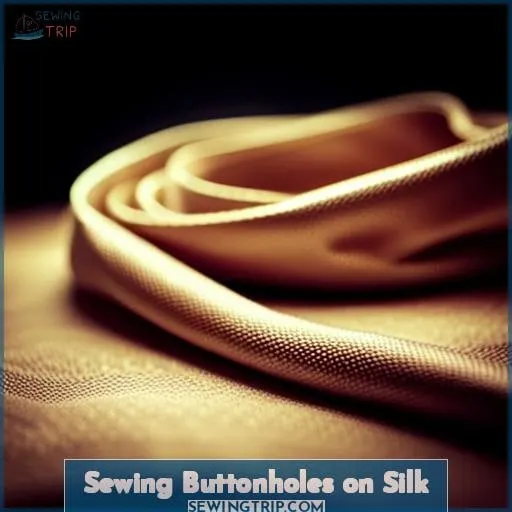This site is supported by our readers. We may earn a commission, at no cost to you, if you purchase through links.
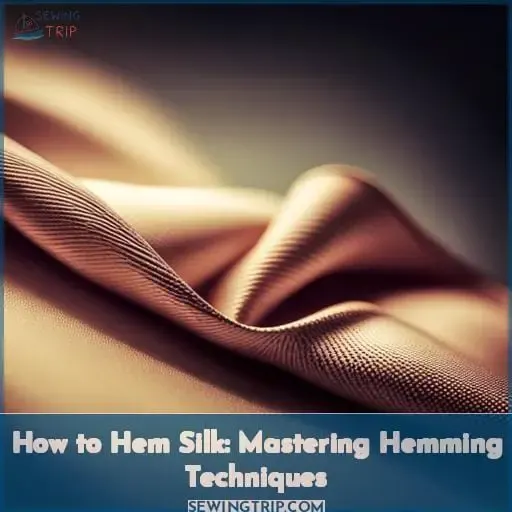 Unlock the art of mastering silk hemming techniques and achieve a level of mastery that brings liberation to your sewing endeavors.
Unlock the art of mastering silk hemming techniques and achieve a level of mastery that brings liberation to your sewing endeavors.
Hemming silk, with its inherent slipperiness and delicate nature, has long posed a challenge for many. In this comprehensive guide, embark on a journey towards hemming silk with finesse and intimacy. Conquer its unique quirks, whether you’re dealing with silk charmeuse or lightweight blends.
Discover the tools and preparation methods required for this delicate task. Master cutting techniques that suit silk’s specific characteristics. Unveil machine sewing guidelines, and explore both hand and machine hemming methods tailored for silk.
Furthermore, delve into the intricacies of working with bias-cut silk and sewing buttonholes.
By the article’s conclusion, you will have gained the mastery needed to elegantly hem silk fabrics. Your achievements will be showcased through results that embody both precision and artistry.
Table Of Contents
- Key Takeaways
- Hemming Silk: Basics and Challenges
- Tools for Hemming Silk
- Preparing Silk Fabric for Hemming
- Cutting Silk Fabric: Techniques and Tips
- Machine Sewing Silk: Guidelines
- Hemming Silk: Hand and Machine Methods
- Pressing Silk: Techniques and Tips
- Working With Bias-Cut Silk
- Sewing Buttonholes on Silk
- Finishing and Sources
- Conclusion
Key Takeaways
- Overcoming challenges of working with slippery and delicate silk.
- Preparing silk through pre-washing, stiffening, and considering fabric nap.
- Exploring hemming techniques including hand-rolled, machine-rolled, and serger rolled hems.
- Achieving polished results with proper pressing, stitching guidelines, and special considerations for bias-cut silk.
Hemming Silk: Basics and Challenges
Hemming Silk: Basics and Challenges
Pinning delicate silk fabric accurately, despite its drapey nature, can be quite a challenge. This is especially true when aiming for that perfect, straight double-fold finish. Achieving a flawless hem on silk involves navigating its slipperiness and tendency to fray.
To conquer these challenges, meticulous preparation of the silk fabric is essential. Start by focusing on precise cutting, taking into consideration silk’s grain and nap.
When it comes to hemming techniques, there are two primary options: hand-rolled and machine hemming. Both approaches offer distinct advantages, and the choice depends on the type of silk fabric and your desired outcome.
Hand-rolled hems bring a touch of artisanal elegance to the fabric. This technique requires careful folding, basting, and stitching.
On the other hand, machine hemming takes advantage of specialized tools like a blind hem foot. This approach ensures a clean, professional edge to the hem. It’s all about achieving precision through mechanical means.
Ultimately, the choice between these methods comes down to what you’re aiming for. Whether it’s finding liberation through the artistry of hand craftsmanship or attaining mastery in the realm of machine precision, each technique has its place in the world of silk hemming.
Tools for Hemming Silk
Introducing a selection of essential tools tailored to refine your silk hemming endeavors. Embrace the precision of Glass Head Pins – Extra Fine, designed to glide effortlessly through delicate silk fabrics.
Elevate your hand basting techniques with Italian Cotton Basting Thread – Torre, a legacy of Italian craftsmanship. This thread offers both strength and gentle finesse, facilitating temporary fabric holds with grace.
Seamlessly transition to machine work with the Vanish-Extra Water Soluble Thread Spool. This versatile choice caters to commercial and longarm machines. It dissolves seamlessly under specific conditions, while its strength shines in intricate applications.
Enrich your repertoire with the Multi-Size Rolled Hem Presser Foot Set. This set encompasses stainless steel presser feet of varying widths. It enables you to achieve polished rolled hems, infusing your projects with a touch of professional elegance.
Glass Head Pins – Extra Fine
Venturing into the realm of delicate silk fabric manipulation mandates an embrace of tools like the Glass Head Pins – Extra Fine. These pins, meticulously designed, ascend to enhance your silk hemming undertaking.
Precision characterizes pinning techniques with their remarkably slender 0.5mm shaft, thereby minimizing unsightly holes and marks. The glass heads, resistant to the rigors of heat, stand as sentinels of fabric preservation amidst ironing endeavors.
Forged from nickel-plated steel, their durability remains unquestioned. The provision of a reusable storage box streamlines pin extraction, affording you the concentration needed for your magnum opus.
Italian Cotton Basting Thread – Torre
Embark on your sewing journey with the Italian Cotton Basting Thread – Torre, a thread that effortlessly glides through fabrics like a breeze on a tranquil day. Crafted from 100% pure Italian cotton, this thread is a masterpiece of temporary fabric holding.
Its strength and delicate touch are harmoniously balanced, ensuring secure basting while yielding gracefully to pressure.
The thread’s colorless nature preserves your creations, and its compatibility with various techniques makes it a true asset in the art of sewing. Torre Thread offers several benefits, including effortless gliding through fabrics and a firm hold that yields under pressure.
It also preserves fabric integrity, leaving no marks due to its colorless composition.
In addition, Torre Thread is compatible with various sewing techniques, as it is tangle-free and well-wound for easy use. Its Italian craftsmanship is at its finest, providing strength for secure basting and easy removal when needed.
Torre Thread truly embodies the essence of quality and reliability, making it an essential tool for any sewing project.
Vanish-Extra Water Soluble Thread Spool
Introducing a remarkable solution that seamlessly dissolves the boundaries between strength and versatility, enhancing your sewing experience with each stitch – the Vanish-Extra Water Soluble Thread Spool.
Key Features:
Strength Beyond Compare: This thread boasts exceptional strength, making it ideal for high-speed machines and intricate designs.
Versatility in Applications: Use it as a top or bottom thread; it’s perfect for embroidery, basting, and trapunto work.
Dissolves with Precision: While requiring soaking, gentle massaging aids quicker dissolution based on stitch density.
Visible During Use: Unlike some threads, it’s easy to see, ensuring precision.
Challenges in Hand Sewing: Knotting can be a bit tricky, but it’s a minor concern.
Elevate your sewing projects with the Vanish-Extra Water Soluble Thread Spool, where strength meets versatility in every stitch.
Multi-Size Rolled Hem Presser Foot Set
Crafting elegant and polished edges becomes effortless with the Multi-Size Rolled Hem Presser Foot Set. Meticulously designed stainless steel presser feet in sizes of 3 mm, 4 mm, and 6 mm are featured in this set, these versatile tools seamlessly complement lightweight fabrics.
They are compatible with sewing machines that boast over 15 stitch patterns. Please note their incompatibility with older, industrial, or mini sewing machines to ensure a professional touch in every stitch.
Preparing Silk Fabric for Hemming
To properly prepare your silk fabric for hemming, commence by pre-washing and fully drying it as per the provided care instructions. Additionally, for those aiming to bolster the fabric’s stability, contemplate the employment of gelatine for stiffening silk.
This technique can bestow a controlled rigidity suitable for meticulous hemming and sewing procedures.
Pre-wash & Dry Your Fabric
Pre-wash and dry your silk following the care instructions before hemming to help prevent potential shrinkage issues later on. This step allows the fabric to relax and shrink prior to sewing. Thus, you can factor in the shrinkage when cutting the pieces and avoid ending up with mismatched hem lengths after laundering.
Double-check to ensure that seam allowances, interfacing choices, and any stabilizer strips will effectively prevent fraying while also matching the final measurements post-washing. Properly preparing the silk in advance leads to a quality hem that maintains its integrity throughout wear and washing.
Stiffening Silk Using Gelatine
After pre-washing your silk, ensure to stiffen it slightly using gelatine to prevent fraying and shifting during sewing. Employing a light gelatine bath aids in stabilizing delicate silk before cutting and hemming, thereby leading to a smoother and more frustration-free sewing experience.
- Immerse the silk in a diluted gelatine solution.
- Remove excess liquid by gently squeezing.
- Flatten the silk by pressing it to dry.
- The application of the gelatine will result in the fabric stiffening.
- Evaluate the level of stiffness prior to commencing the hemming process.
Cutting Silk Fabric: Techniques and Tips
When dealing with slippery silk textiles, it’s essential to exercise special care during the cutting process. For precise pattern piece shapes and impeccable grain alignment, opt for pattern weights over pins.
Cut one layer at a time, and transfer markings using silk thread and needles. Moreover, meticulous attention should be given to the fabric’s nap and grain.
Shifty Fabric Cutting
Cut each layer individually to prevent shifting while working with shifty fabrics. Secure each layer with pins separately to handle the material delicately. Ensure that the cut edges are aligned properly to avoid folding excess fabric into the seams.
Press and clean the fabric promptly to prevent the fibers from stretching and distorting the grain. When assembling pinned pieces, use a narrow zigzag or double zigzag seam for a tidy finish on shifty silk.
Employing a narrow hem foot will give a polished look to the project’s hem. With attention to detail and the appropriate techniques, even slippery silk can be sewn and hemmed gracefully.
Transferring Pattern Markings
Handling delicate silk fabrics, precise pattern markings serve as your navigational guides through uncharted waters. Similar to a skilled navigator plotting stars for guidance, transferring markings onto silk steers your sewing journey.
Utilize marking tools and techniques judiciously, such as basting or tailor’s tacks, to ensure utmost accuracy. In order for pattern markings to effectively lead your way, hone the art of their transfer, harmonizing with your pursuit of sewing mastery.
Handling Fabric Nap
Ensuring your silk fabric lies smoothly and presents its best requires meticulous attention to the direction of the fabric nap. The nap pertains to the minuscule fibers on the fabric’s surface, naturally arranged in a single direction.
When cutting silk, take into account the alignment of the nap to achieve a consistent color and sheen. Sewing while considering the nap guarantees that the fabric uniformly captures and reflects light.
While exploring techniques like serger rolled hems or pick-stitched hems, keep nap considerations in your thoughts.
Pattern Weights Vs. Pins
Embrace the dance of choice between the weighty guardians and the delicate prickers as you decide whether to place your faith in the steadfast pattern weights or the ever-faithful pins—each holding the power to steer your silken creation towards perfection.
Here’s a rundown of how these sewing tools influence your fabric handling and hemming techniques:
Pattern Weights: Gently resting atop the fabric, pattern weights minimize distortion, allowing for accurate cutting. They’re ideal for delicate silk, preserving its integrity.
Pin Alternatives: Pins, those trusty companions, secure fabric layers for precise cutting. Yet, they can cause slight shifting or mark delicate silk, demanding careful placement.
Fabric Handling: Pattern weights offer stability without piercing, a boon for intricate silks. Pins, though precise, require extra attention to prevent fabric distortion.
Hemming Techniques: Whether pattern weights or pins, both tools assist in maintaining fabric alignment during hemming. Choose according to your comfort and silk’s nature.
Straight Stitches: When using pattern weights, straight stitches along the hem benefit from unwavering fabric position. Pins assure secure alignment for consistent stitching.
Decide wisely, for pattern weights and pins shape your silk’s journey from cut to hem, offering distinct advantages for a seamless, elegant outcome.
Machine Sewing Silk: Guidelines
Embark confidently into the realm of machine-sewing silk, delving into the intricacies of stitch settings tailored for this delicate fabric. Navigate the challenge of preventing fabric shifting while sewing, all the while exploring a variety of seam options and finishing techniques that bestow a refined edge upon your silk creations.
Stitch Settings for Silk
Navigate the realm of machine sewing silk with finesse—let stitch settings be your guide in transforming delicate fabric into a masterpiece.
Experimenting with stitch settings offers a palette of options to tailor your sewing approach. Adjust tension for balanced stitches, choose appropriate needle options, and match thread thickness.
Seam choices influence the fabric’s drape. For lightweight silk, opt for a shorter stitch length.
Explore decorative stitches to add a unique flair to your creations. Also, consider tips for sewing buttonholes on silk to achieve secure and neat results. Your stitch settings unlock the potential for silk sewing projects that exude elegance and mastery.
| Aspect | Consideration |
|---|---|
| Tension | Balance for even stitches |
| Needle Options | Select based on fabric weight |
| Thread Thickness | Match to fabric and stitch choice |
| Seam Choices | Influence fabric drape |
| Stitch Length | Shorter for lightweight silk |
| Bias-Cut Silk | Utilize stabilizing stitches |
| Buttonholes | Employ techniques for secure and neat results |
| Decorative Stitch | Add unique details to your silk creations |
| Working with Bias-Cut Silk | Stabilizing stitch to prevent stretching |
Preventing Fabric Shifting
Secure in your grip, the fabric lies tranquil as you prepare to weave your magic into the delicate material, ensuring that every stitch you craft is a testament to your skill and meticulous attention to detail.
To avert fabric shifting during machine sewing on silk, employ a fusion of techniques. Commence with precise pinning, ensuring the fabric remains steady. Subsequently, embrace the art of hand basting, gently uniting the layers.
Lastly, make use of the blind hem foot, a tool that resolutely guides the fabric, eradicating any unwelcome shifts.
Seam Options & Finishing Edges
Seam Options & Finishing Edges
Explore the world of finishing edges and enhancing seams as you journey through the realm of crafting with delicate fabrics like silk. Elevate your silk creations using these seam varieties and hemming techniques, ensuring a flawless finish that exudes elegance.
French Seam Perfection:
Embrace the clean lines of French seams, enclosing raw edges to achieve a polished look.
Bound to Beauty:
Opt for bias-bound seams to add durability and a pop of contrasting color.
Hong Kong Harmony:
Master the art of Hong Kong seams by binding edges with silk for a luxurious touch.
Rolled Hem Radiance:
Choose machine-rolled hems for lightweight silk, delivering an exquisite edge.
Pick-Stitched Panache:
Achieve hand-rolled hems with pick-stitched precision, showcasing your dedication.
Transform your silk seam finish into an art form, embodying mastery and intimacy in every stitch.
Hemming Silk: Hand and Machine Methods
Embarking on the realm of refined silk hemming, this section delves into the meticulous craft of leveling hems. It presents an array of hemming alternatives that cater to distinct preferences. Immerse yourself in the precision of the machine-rolled hem, the finesse of the serger-rolled hem, and the timeless allure of the hand-rolled — or handkerchief — hem.
Leveling a Hem
Ensuring your fabric’s elegance flows uninterrupted involves employing the artful technique of leveling the edge, guaranteeing a finish as smooth as a calm river’s embrace. Hemming silk demands precision, and leveling the hem is no exception. Accurately adjusting lengths is crucial for a flawless outcome.
Utilize hemming tools such as a sewing gauge to measure and mark consistent distances, overcoming hemming challenges with finesse.
Various Hemming Options
Experiment with a variety of finishing techniques, like French seams, bias-bound seams, or Hong Kong seams, to impart a touch of elegance and robustness to your delicate fabric projects. These specialized techniques enhance both the visual appeal and the longevity of your silk creations.
French seams neatly encapsulate raw edges, offering a polished and refined appearance. Bias-bound seams present contrasting or coordinating edges, while Hong Kong seams showcase bound edges for a truly luxurious finish.
Machine Rolled Hem
Achieving a flawless, machine-rolled finish on delicate fabrics such as silk involves mastering the precision art. The distinctive properties of silk pose challenges in hemming, requiring appropriate sewing techniques and hemming tools.
To begin, fold the hem edge by approximately 1 cm and adjust your machine to employ a narrow zigzag stitch with fine thread. Patiently guide the fabric through the machine, thereby creating a exquisitely rolled hem that enhances the elegance of silk garments.
Serger Rolled Hem
Dive into the realm of serger magic as your stitches effortlessly transform delicate fabric edges into a cascade of elegance, adding a whisper of sophistication to your sewing creations. By utilizing a serger for hemming silk, you can enjoy a range of advantages, including taming silk fraying and achieving impeccably finished edges.
Explore serger settings tailored to silk’s fineness and embrace the various rolled hem alternatives that this versatile machine offers. Delve into the ongoing serger vs sewing machine debate for hemming silk, where the serger’s precision and speed take the lead.
Hand Rolled (Handkerchief) Hem
Explore a classic technique for adding a touch of elegance to your delicate fabric – the exquisite art of creating a hand-rolled hem. This method, known for its timeless charm, involves meticulously folding the fabric’s edge twice, encasing the raw edge within, and then delicately hand-stitching it in place with an invisible stitch.
Let’s delve into a comparison of hemming techniques, highlighting the benefits of this approach for silk fabrics.
| Silk Hem Variation | Invisible Stitching | Hand Hem Benefits |
|---|---|---|
| Hand-Rolled Hem | Neatly Concealed | Timeless Elegance |
| Machine-Rolled Hem | Camouflaged Seam | Effortless Precision |
| Blind Hem | Seam Concealed Inside | Professional Finish |
When comparing silk hem variations, the hand-rolled method stands out. Its invisible stitching creates an exquisite finish, ideal for lightweight silk like charmeuse. The benefits encompass an intimate connection with your creation and mastery over a traditional craft.
Troubleshooting tip: If stitches become visible, adjust tension.
Elevate your silk projects with this intimate mastery of the hand-rolled hem technique.
Pressing Silk: Techniques and Tips
Exploring the intricacies of silk pressing, you’re ready to delve into essential techniques that uphold the fabric’s delicate nature. Start by acknowledging the significance of pressing from the back – a method carefully employed to preserve the silk’s sheen and mitigate any risk of unwanted creasing.
To complement this practice, strategically use a pressing cloth, which forms a pivotal shield, ensuring optimal heat distribution and safeguarding the silk satin’s lustrous surface during the pressing process.
Pressing From the Back
Pressing From the Reverse
To guarantee impeccable and flawless outcomes in your fabric finishing, gently press the reverse side of your delicate material. This technique ensures the preservation of the intricate texture and luxurious sheen of your exquisite fabric.
For instance, when preparing an elegant evening event, a silk blouse with a ruffled hem benefits from backside pressing, maintaining the fabric’s opulent appearance while perfectly setting the hem in place.
- Safeguard delicate fabric through backside pressing.
- Maintain the intricate texture and luxurious sheen.
- Set hems flawlessly to achieve an elegant appearance.
Using a Pressing Cloth
Enhance your ironing finesse by draping a lightweight pressing cloth over your delicate fabric before pressing. This simple yet effective technique ensures your fabric’s integrity while imparting a flawless finish.
The benefits of using a pressing cloth are multifaceted. It safeguards your silk from direct heat, preventing shine, scorch marks, or color transfer.
Various types of pressing cloths cater to different fabric sensitivities. Muslin and silk organza are among the options. Employing a pressing cloth demands finesse. Adjust the heat settings and avoid applying excessive pressure to master this essential silk-care art.
Pressing Cloth Benefits
- Shields from direct heat
- Prevents shine, marks, transfer
- Enhances fabric integrity
- Enables precise pressing
Pressing Cloth Types
- Muslin
- Silk organza
- Cotton
- Terry cloth
Using Pressing Cloth
- Place the cloth between the iron and fabric
- Ensure even coverage
- Glide smoothly; avoid tugging
- Protect delicate embellishments
Pressing Cloth Tips
- Adjust heat and pressure
- Use a clean cloth
- Test on scrap fabric
- Keep cloth lint-free
Mastering this subtle art heightens your mastery of silk, offering intimacy with its nuances. Dive into this process, liberating your silk projects from potential damage while fostering a deeper connection with the art of ironing.
Ironing Silk Satins
Glide the iron gently over the luxurious satin, allowing its smooth surface to dance beneath the warm touch, ensuring you retain its exquisite luster and grace. Ironing silk satin demands finesse. Set your iron to a low silk setting and ensure it’s clean.
Start ironing from the reverse side, employing light, even strokes. Use a pressing cloth to safeguard the delicate fibers from direct heat.
Working With Bias-Cut Silk
Introducing techniques for working with bias-cut silk fabric: Ensure stability through stay stitching, alleviate distortion by employing zig-zag seams, and prevent excessive stretching during sewing. By implementing these methods, you can optimize your projects involving bias-cut silk, enhancing precision and preserving the fabric’s integrity.
Stay Stitching for Stability
To ensure stability in your bias-cut silk, employ stay stitching techniques to fortify the fabric’s structure and prevent any undesirable shifts during the sewing process. Stay stitching benefits your project by addressing the challenges posed by bias cuts, which tend to stretch and distort.
This stitching technique involves sewing a row of stitches within the seam allowance, effectively anchoring the fabric’s edge. This practice not only enhances fabric stability but also maintains sewing precision.
Zig Zag Seams on Bias-Cut Fabric
Mastering the skill of working with bias-cut fabric involves deftly maneuvering zig-zag seams, imbuing your creations with a dynamic amalgamation of stability and flexibility. When dealing with bias-cut silk, zig-zag seams become a pivotal technique. These seams provide the essential stretch to accommodate the inherent give of the bias, thereby preventing unseemly puckering and distortion.
To execute this, configure your sewing machine to employ a narrow zig-zag stitch. Proceed to stitch along the fabric’s edge, allowing the zig-zag to traverse the edge of the seam. This technique blends exquisitely with other seam finishes, elevating the integrity of your bias-cut projects.
Avoid Stretching While Sewing
Handle the delicate bias-cut fabric as gently as you would cradle fragile glass, avoiding any unnecessary stretching while sewing, like a whisper through a delicate breeze. Preventing puckering and maintaining stitching tension are paramount. Employ stabilizing techniques like tissue paper or delicate sewing machine feet designed for bias-cut fabrics.
Seam distortion is a potential concern, so support the fabric as you stitch, allowing it to glide seamlessly through the machine.
Sewing Buttonholes on Silk
Crafting buttonholes on this delicate fabric involves a meticulous balance between precision and finesse, as the silk’s inherent qualities demand an attentive approach to achieve flawless results.
Silk buttonhole techniques merge craftsmanship with artistry, requiring a thoughtful choice of tools and strategies. When sewing buttonholes on silk, prioritize using a fine, sharp needle to pierce the fabric smoothly, preventing snags.
Utilize lightweight interfacing to reinforce the area and stabilize the silk’s delicate fibers. Employ a buttonhole foot to guide the stitches accurately and consistently, ensuring uniformity.
Ensure that stitch length and density are crucial factors; opt for a slightly shorter stitch length to prevent fraying.
Remember to practice on scrap silk before attempting your project, as silk buttonholes demand patience and precision. By embracing these silk buttonhole tips, you will attain elegant, flawlessly finished silk creations that epitomize craftsmanship and mastery.
Finishing and Sources
Transitioning from the meticulous process of sewing buttonholes on silk, let’s delve into the essential realm of finishing techniques and valuable sources to perfect your silk hemming journey.
Silk hemming techniques are your allies in overcoming inherent challenges like slipperiness and fraying. Employ options such as serging, stitching, and pinking, double zigzag seams, or delicate hand hemming to achieve a flawless finish.
Ensuring your silk fabric is impeccably prepared through careful washing, drying, and pressing will set the foundation for your hemming success. When cutting silk, remember to honor its grain and nap, employing pattern weights, and cutting single layers for shifty fabrics.
Navigating the realm of machine sewing, adjust settings and consider the aid of a walking foot to prevent fabric shifts. Your path to silk mastery is paved with these gems of wisdom, culminating in a refined and polished hem that mirrors the grace of the fabric itself.
Conclusion
To master the art of hemming silk, it’s essential to have the right tools and techniques.
In this comprehensive guide on how to hem silk, we’ve got you covered—from understanding the basics and challenges of hemming silk to learning cutting, sewing, and pressing techniques. Whether you’re into handcrafting or using a sewing machine, our Multi-Size Rolled Hem Presser Foot Set will be your reliable companion.
So, whether you’re preparing silk for a special garment or crafting elegant silk curtains, you now have the knowledge and tools needed to achieve perfect silk hems.
Happy sewing!


